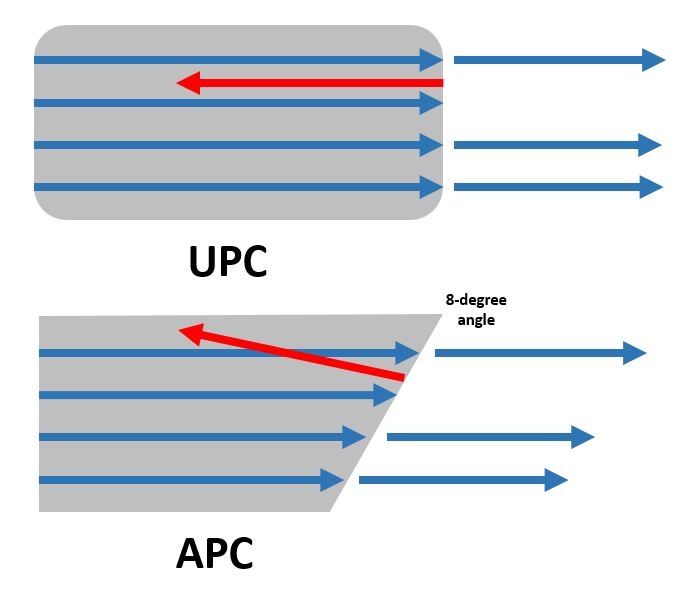APC vs. UPC: What’s the Difference?
Editor’s Note: This blog was originally published on Aug. 14, 2014. Since then, it has received lots of great feedback – including questions about fiber connector loss. So we updated this piece in August 2019 to include that information! Read on to discover details about connector loss.
Ever wonder what the difference is between ultra physical contact (UPC) and angled physical contact (APC) singlemode fiber connectors and which one to use? As usual, the answer is, “It depends.”
Let’s take a closer look.
Eight Degrees of Separation
The main difference between APC and UPC connectors is the fiber endface. APC connectors feature a fiber endface that is polished at an eight-degree angle; UPC connectors are polished with no angle. UPC connectors are not exactly flat, however; they have a slight curvature for better core alignment. Another more obvious difference is color. UPC connectors are blue while APC connectors are green.

What does this difference mean in terms of performance? With UPC connectors, any reflected light is reflected straight back toward the light source. The angled endface of the APC connector causes reflected light to reflect at an angle into the cladding vs. straight back toward the source. This causes some differences in return loss, which is a measurement of reflected light that is expressed as a negative dB value (the higher the value, the better). Industry standards recommend that UPC connector return loss should be -50 dB or greater, while APC connector return loss should be -60 dB or greater.

Remember, return loss is different than insertion loss, which refers to the amount of optical power lost through a connector or cable length. Insertion loss is what we use to determine loss budgets. Achieving low insertion loss is typically easier with UPC connectors due to less air gaps than APC connectors; however, manufacturing techniques have improved significantly to create more precise angles on APC connectors and bring insertion loss closer to that of UPC connectors.
In fact, insertion loss on Belden’s FiberExpress connectors is the same for UPC and ACP singlemode connectors. Our FiberExpress Fusion Splice-On Connectors exceed standards when it comes to insertion loss.
FiberExpress Fusion Splice-On Connectors: Insertion Loss
| Fiber Type | Maximum Insertion Loss | Minimum Return Loss | Connector Color | |
| OS2 APC | 9 micron single mode | 0.3 dB | -65 dB | Green |
| OS2 UPC | 9 micron single mode | 0.3 dB | -55 dB | Blue |
FiberExpress Brilliance Universal Connectors
| Fiber Type | Maximum Insertion Loss | Minimum Return Loss | Connector Color | |
| OS2 APC | 9 micron single mode | 0.5 dB | -60 dB | Green |
| OS2 UPC | 9 micron single mode | 0.5 dB | -50 dB | Blue |
Application Considerations
Some applications are more sensitive to return loss than others; they call for APC connectors. For example, in higher optical wavelength ranges (above 1500 nanometers) like those used for RF video signals, reflected light can adversely impact the signal. That is why we see APC connectors being used by most cable companies and other FTTX providers in outside plant applications.
APC connectors are also commonly used in passive optical applications (both GPONs and passive optical LANs) due to the fact that many of these systems also use RF signals to deliver video. Future higher-speed passive optical networks and other WDM applications that will use higher wavelengths via singlemode fiber will also likely require the reduced return loss of APC connectors.
One thing that should be noted is that APC and UPC connectors cannot and should not be mated. Not only does mating cause poor performance because the fiber cores will not touch, but it can also destroy both connectors. The last thing you want to do is cause permanent transmitter damage—especially with higher-cost singlemode equipment.
Another important point: Cable loss is typically the smallest contributor to system attenuation. The largest loss comes from the connector. Higher-performing connectors offer dB savings that are more significant, measurable and consistent.
Have questions about fiber connector loss? Send us a note and we'll answer them!
